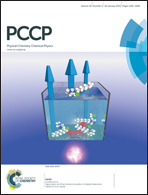Graphene nanopores: electronic transport properties and design methodology†
Abstract
Graphene nanopores (GNPs) hold great promise as building blocks for electronic circuitry and sensors for biological and chemical sensing applications. Methods to design graphene nanopores that achieve desirable conduction performance and sensing characteristics have not been previously described. Here we present a study of the quantum transport properties of GNPs created by drilling pores in armchair and zigzag graphene ribbons. For the first time, our study reveals that the quantum transmission spectra of GNPs are highly tunable and GNPs with specific transport properties can be produced by properly designing pore shapes. Our investigation shows that the biological sensing capabilities of GNPs are transmission spectrum dependent, can vary dramatically, and are critically dependent on pore geometry. Our study provides design guidelines for creating graphene nanopores with specific transport properties to meet the needs of diverse applications and for developing sensitive biological/chemical sensors with required performance characteristics.


 Please wait while we load your content...
Please wait while we load your content...